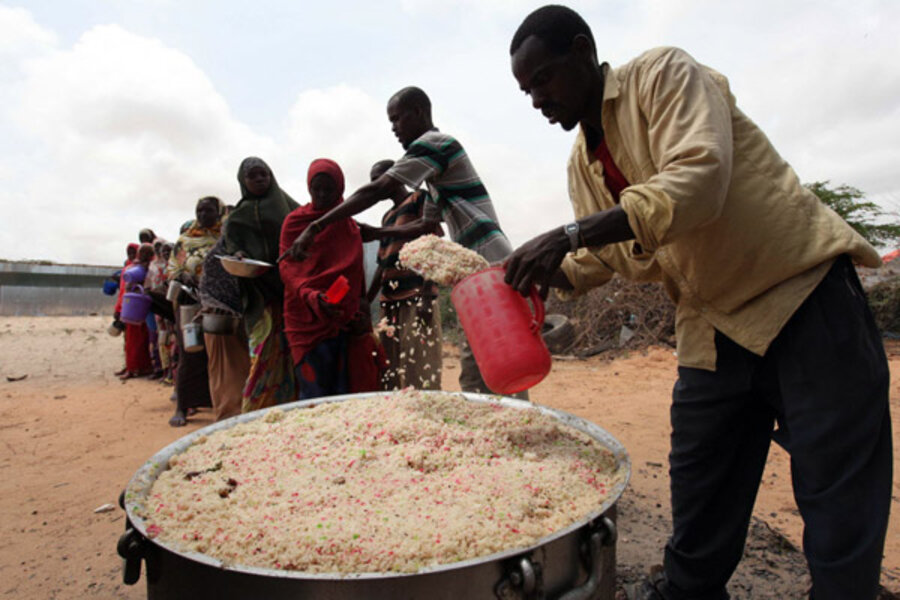Somalia famine spreads to new region in south; warning issued on aid
Loading...
| Washington
Famine has gripped another swath of southern Somalia, according to the United Nations, with more than 750,000 of the country’s nearly 8 million people now at risk of starvation.
And with fewer Somalis every day possessing the energy or means to flee the famine’s extending reach, it is critical, some humanitarian experts say, that aid efforts no longer rely on affected populations getting to refugee camps that have mushroomed in neighboring countries, such as Kenya.
Instead, food and other assistance must reach the starving in southern Somalia, they say.
Tens of thousands of people – in large part children – have died in the Horn of Africa country since July when a state of famine was declared, the UN says.
On Monday UN officials added Somalia’s Bay region to the list of famine zones, making it the sixth region to join the list. Nearly two-thirds of all children in the Bay region are acutely malnourished.
Famine could spread to include all of southern Somalia before October rains arrive and begin to alleviate the country’s dire conditions, officials say.
Speaking to reporters in Nairobi Monday, the UN’s humanitarian coordinator for Somalia, Mark Bowden, said the only way to reduce the anticipated number of famine-related deaths would be a massive influx of international aid. The international community must also “refocus” its aid efforts on southern Somalia, he added, which he called the “epicenter” of a drought-related crisis affecting the entire Horn of Africa.
While all of Somalia suffers from having a government in name only, it is particularly hard to get aid into the south, which is controlled to some degree by Al Shabab, an Al Qaeda-affiliated extremist organization. The group’s fighters prevent the hungry from leaving in search of assistance, and until recently the group banned all aid groups from the south, claiming famine was a Western fabrication.
Al Shabab leaders recently relented and have started allowing the International Committee of the Red Cross/Red Crescent and some Muslim charities to deliver aid in southern Somalia. But some residents of southern Somalia, as well as some in the capital of Mogadishu, complain that aid deliveries are often commandeered by armed men – who presumably take food supplies to feed soldiers or militants.
The UN reports that funding of anticipated assistance needs for the entire Horn of Africa is a little less than $1 billion short – which is actually a small improvement since the UN issued an international appeal in July.
The US is by far the largest single donor of drought-related assistance to Somalia and the Horn of Africa, having provided more than a half-billion dollars of assistance in the past year. Last week the head of the US Agency for International Development, Rajiv Shah, announced another $23 million in US aid to fight the famine.
Speaking Wednesday in Minneapolis, home to one of the largest concentrations of Somali immigrants in the United States, Dr. Shah reiterated recent assurances that the US will not prosecute aid groups whose assistance unwittingly falls into the hands of groups like Al Shabab. Aid groups have reported pulling efforts from Somalia in part over fears of running afoul of US antiterrorism laws.
“Any partner working with the government, or USAID in particular, will be immune from that type of prosecution,” Shah said in response to an audience question.
Whether the last month’s increase in international assistance to Somalia will continue is likely to be one of the factors determining the country’s short-term prospects.
Another factor will be Somalia’s governability. The UN this week is holding a conference of political leaders in Mogadishu to try to resolve a governing crisis that began when the central authority collapsed in 1991. On Tuesday it was announced that the leaders had adopted a “road map” to hold elections within a year, but the plan did not involve Al Shabab, calling into question how stabilizing the move would be.
But in the short term, international assistance is likely to be the primary ingredient for staving off even worse disaster, humanitarian experts say. The Famine Early Warning Systems Network, a UN project funded in part by the US, said Monday that Somalia faces total “social collapse” without a massive international response.





